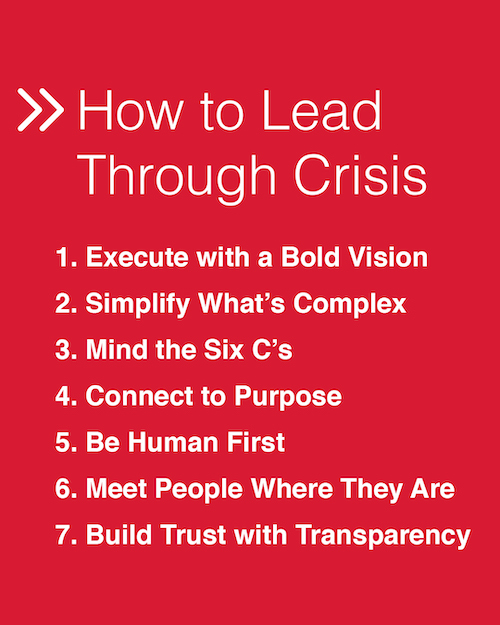by Linda Descano, CFA®, Executive Vice President, Red Havas, and Lesley Sillaman, Senior Vice President, Red Havas
How CEOs behave during crises as leaders—and as humans—will set up brands and businesses for their greatest chance of success and growth in the long term. As such, there’s never been a better time for leaders to hone their communications skills. We recently collected and analyzed examples of how top executives are demonstrating best practices for communication during the COVID-19 crisis, which we shared in a white paper, Leading Through Crisis: Communications Lessons and Opportunities.

Earlier this month, we sat down with experts in communications, media and leadership in a two-part webcast hosted by Dino Delic of Meltwater to explore the seven principles of effective communications that we distilled from our analysis and to discuss their implications.
Joining us for this conversation were Shannelle Armstrong Fowler, adjunct professor of brand strategy, consumer behavior and marketing at Columbia College Chicago, and Henna Inam, CEO of Transformational Leadership Inc. and author of Wired for Disruption and Wired for Authenticity.
You can listen to the webcasts here.
Below are some highlights from our conversation that touch on these and related leadership themes:
On managing disruption: “Practice neuro-emotional agility, which is the ability to be able to reset your body and your brain so that you can restore yourself to a state of calm. And then from that state of calm, you and your team can manage the situation in a much more powerful way.” —Henna Inam
On the power of vulnerability: “There’s something humanizing and there’s something really important about a leader showing confidence and calm, but also confidence when your voice trembles, when you are afraid. You can still be confident and have that moment of feeling, like, ‘You know, it doesn’t feel good right now.’ It’s powerful to see leaders being their whole, authentic selves and look at communications from the perspective of their lives, the lives of their families, the lives of their employees and families, and the broader communities. This experience has raised expectations of leadership.” —Shannelle Armstrong Fowler
On making good decisions: “In times of crisis, being able to really be connected and have the right relationships and the best interests of your stakeholders at heart is what helps people make great decisions.” —Henna Inam
On connecting to purpose: “They need to make it part of their brand. They need to communicate this consistently and clearly—and not mince words. They need to communicate their beliefs through their social channels, on their packaging, in their digital space. And their actions must speak louder than words.” —Shannelle Armstrong Fowler
On the power of calm: “When we show up as leaders in a very calm, cool and collected manner, it actually has an emotional impact on the people that we lead, the people that are part of our audience, which is so critical.” —Henna Inam
On CEOs as “brand human”: “There was a time when CEOs didn’t have to be their own brand. And so now that they have to be their own brand, they’re very clear that more is required. Leaders need to create an ecosystem of communication that says, ‘Hey, your safety and your needs are important to me.’ And you have to create that by what you say. And when people feel disconnected from that message, then they don’t believe what you are. They think you stand outside of your brand and your business. Once you satisfy the people who we’re communicating with and serving their basic needs, then and only then can we truly impact someone in their heart, in their spirit, from a human perspective.” —Shannelle Armstrong Fowler
On a values-based approach: “When leaders don’t and can’t predict the future, it can take them off-kilter, because they’re so used to being able to be in control and ‘plan-ful.’ But I think this time is teaching us to step much more into values and stakeholders and caring for our people and making decisions from that place. Knowing that this is the right thing to do at this time with the information that I have in hand.”—Henna Inam
On communicating without the asterisk: “When you tell that story, you have to communicate with transparency. I always like to say, ‘Communicate with transparency and without the asterisk.’ Like ‘We believe; however…’ or ‘we believe, comma, but…” Unintentionally, when we qualify what we say, we’re allowing people to dissect our communication, dismiss the first part and solely focus on the bad. So communicating without an asterisk is going to be important as we move forward to build trust.” —Shannelle Armstrong Fowler
On building trust: “If you look at trust, there are two components of it. There is the credibility component, which is ‘Do I make promises? And do I keep my promises? And can I count on you to do that?’ And the second is what I call vulnerability-based trust. It’s the ability to know, ‘Does this person mean well for me, and are they able to, human-to-human, share their failures, openly share who they are? Are they able to admit when they’ve made mistakes?’ The combination of that vulnerability plus the credibility can generate a powerful turnaround in reputation for leaders and brands.” —Henna Inam
LinkedIn Live
On being human: “The reality is that all companies—and people—stumble. It’s not the act of the stumble, though, that creates an issue. It’s the response that becomes the issue. And what we hope to see in leaders today is that the buck starts and stops with them.” —Shannelle Armstrong Fowler
Our partners at Meltwater are hosting a LinkedIn Live on Wednesday, July 29, at 2 p.m. ET/11 a.m. PST to continue the conversation—and we hope you will join us.
To join, go to Meltwater’s LinkedIn page at that time and start watching! If you’d like to get an event reminder, like the page.
If you are reading this after our Live session, you can still check out the webcasts on Meltwater’s LinkedIn page.